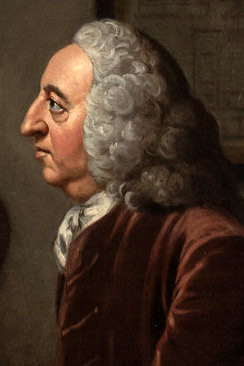William Oliver (physician) facts for kids
Quick facts for kids
William Oliver
|
|
|---|---|
 |
|
| Born | 14 August [O.S. 4 August] 1695 Ludgvan, Cornwall, England
|
| Died | 17 March 1764 (aged 68) Bath, Somerset, England
|
| Education | Pembroke College, Cambridge, Leiden University |
| Medical career | |
| Profession | Medicine |
| Institutions | Royal Mineral Water Hospital, Royal Society |
William Oliver (born August 14, 1695 – died March 17, 1764) was a British doctor and a kind-hearted person who helped others. He is famous for inventing the Bath Oliver biscuit.
William Oliver was born in Ludgvan, a town in Cornwall, England. He was baptized on August 27, 1695. His family owned the Trevarno Estate. He later sold another family estate, Treneere, after his death.
For his education, he went to Pembroke College, Cambridge in 1714. He earned his first medical degree in 1720 and a higher one in 1725. To finish his medical training, he also studied at Leiden University in the Netherlands in 1720. He became a member of the Royal Society in 1729–30, which is a very important group for scientists.
Contents
William Oliver's Medical Career
After finishing his studies, Dr. Oliver first worked in Plymouth. There, he helped introduce a method called inoculation to protect people from smallpox. This was an early way to prevent the disease.
Around 1725, he moved to Bath and stayed there for the rest of his life. He quickly became one of the most respected doctors in the city. He was good friends with Ralph Allen, who introduced him to famous writers like Alexander Pope. Another friend, Dr. William Borlase, also sent many patients to him.
Helping at the Hospital
Dr. Oliver worked hard to raise money for a new hospital in Bath. This hospital is now known as the Royal Mineral Water Hospital. In 1737, he even offered some of his own land for the hospital site.
The next year, he became one of the people in charge of the hospital's money. In 1740, he was officially named the hospital's doctor. He wrote the rules for how patients from England could be admitted and cared for. Later, he also wrote rules for patients from Scotland and Ireland.
Dr. Oliver led the hospital until 1761, when he retired. A painting by William Hoare shows Dr. Oliver and the hospital's surgeon, Jerry Peirce, examining patients. This painting is still at the hospital today.
The Bath Oliver Biscuit
Dr. Oliver is often said to have invented the Bath bun, a sweet bread roll. However, he found it was too rich for his patients who had joint pain (gout). So, he created something lighter: the 'Bath Oliver' biscuit.
Before he passed away, he shared the secret recipe for the biscuit with his coachman, Atkins. He also gave Atkins money and flour to start a business. Atkins opened a shop and became very successful selling the biscuits. The 'Bath Oliver' is still a popular biscuit today!
Dr. Oliver's Personal Life
In 1746, Dr. Oliver bought a small farm near Bath. He named it Trevarnoe, after the place where he grew up. For many years, he suffered from gout, a painful condition that affects the joints.
He passed away in Bath on March 17, 1764. He was buried in All Saints' Church in Weston, near Bath. There is also a memorial plaque for him in Bath Abbey.
People generally remember Dr. Oliver as a very sensible, kind, and generous person. He helped many people throughout his life.
His son, also named William Oliver, studied at Christ Church, Oxford. Dr. Oliver's second daughter, Charlotte, married Sir John Pringle, who was also a famous doctor.
Dr. Oliver's Writings
Dr. Oliver wrote several books and papers. In 1751, he published Practical Essay on the Use and Abuse of warm Bathing in Gouty Cases. This book was about how warm baths could help or hurt people with gout. It was so popular that it was printed three times.
He also wrote a short, anonymous book about a famous person in Bath named Mr. Nash. This book was praised by the writer Oliver Goldsmith. Dr. Oliver also wrote short medical articles for the Philosophical Transactions, a scientific journal.
He exchanged many letters with famous people of his time, including the poet Alexander Pope and the writer William Warburton. These letters show his connections with important figures in literature and science.

